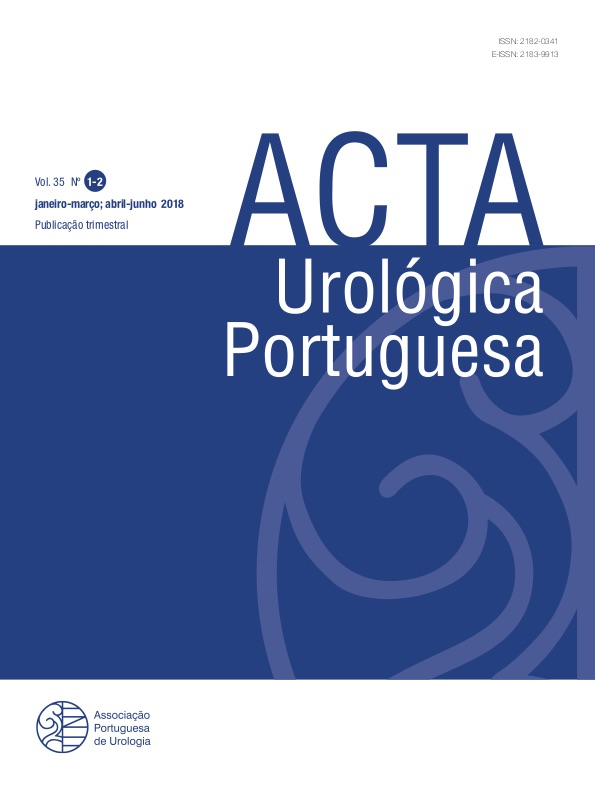Metabolómica no Carcinoma da Bexiga: Estado Atual e Perspetivas Futuras
DOI:
https://doi.org/10.24915/aup.35.1-2.64Palavras-chave:
Biomarcadores Tumorais, Metaboloma, Metabolómica, Neoplasias da Bexiga UrináriaResumo
Introdução: O carcinoma da bexiga é o nono tumor mais comum em todo o mundo e o tumor mais comum do sistema urinário com incidência crescente. Apesar da alta frequência e mortalidade associada a este tumor, pouco evoluiu recentemente quanto ao diagnóstico e tratamento desta patologia. De facto, a cistoscopia e a citologia urinária ainda são os métodos preconizados para a detecção do carcinoma da bexiga. O desenvolvimento de técnicas diagnósticas menos invasivas e mais confiáveis é fundamental. Nesse sentido, a metabolómica surgiu recentemente como uma técnica promissora para o diagnóstico e orientação de doenças oncológicas.
Aquisição de Evidências: Fizemos uma pesquisa exaustiva dos estudos sobre metabolómica e carcinoma da bexiga publicados antes de Outubro de 2017, recorrendo à base bibliográfica da PubMed, Medline e Web of Science. Realizamos uma revisão da literatura, tentando esclarecer o que já é conhecido sobre a aplicação da metabolómica no carcinoma da bexiga e quais as perspectivas futuras.
Síntese de Evidências: A aquisição espectral é feita usando predominantemente duas plataformas analíticas: ressonância magnética e espectrometria de massa. No que diz respeito ao carcinoma da bexiga, vários metabolitos foram associados à presença de tumor, levando à criação de um perfil metabolómico capaz de identificar os pacientes com carcinoma da bexiga. Além do diagnóstico, a metabolómica também foi estudada para estratificar os casos de carcinoma da bexiga de acordo com sua agressividade. Neste sentido, existem estudos que utilizaram a análise metabolómica para distinguir entre tumores vesicais de baixo e alto grau. Uma investigação mostrou que os níveis de carnitina foram maiores nos doentes com carcinoma da bexiga músculo-invasivo do que naqueles com tumores não invasivos, o que sugere que estes achados podem estar correlacionados com a agressividade tumoral.
Conclusão: Os biomarcadores detectados pela metabolómica fornecem uma visão da biologia tumoral e usados de forma adequada poderão levar ao desenvolvimento de novas estratégias para o diagnóstico e tratamento do carcinoma da bexiga.
Downloads
Referências
2. Ferlay J, Soerjomataram I, Dikshit R, Eser S, Mathers C, Rebelo M, et al. Cancer incidence and mortality worldwide: Sources, methods and major patterns in GLOBOCAN 2012. Int J Cancer. 2015;136:E359-E386.
3. Siegel RL, Miller KD, Jemal A. Cancer statistics, 2016. CA Cancer J Clin. 2016;66:7-30.
4. Khandelwal P, Abraham SN, Apodaca G. Cell biology and physiology of the uroepithelium. Am J Physiol Renal Physiol. 2009;297:F1477-501.
5. Kamat AM, Mathew P. Bladder cancer: imperatives for personalized medicine. Oncology. 2011;25:951-8, 960.
6. Lobo N, Mount C, Omar K, Nair R, Thurairaja R, Khan MS. Landmarks in the treatment of muscle-invasive bladder cancer. Nat Rev Urol. 2017;11:476-80.
7. van der Poel H, Debruyne F. Can biological markers replace cystoscopy? An update. Curr Opin Urol. 2001;11:503-9.
8. Konety BR. Molecular markers in bladder cancer: a critical appraisal. Urol Oncol. 2006;24:326-37.
9. Lokeshwar VB, Habuchi T, Grossman HB, Murphy WM, Hautmann SH, Hemstreet GP 3rd, et al. Bladder tumor markers beyond cytology: International Consensus Panel on bladder tumor markers. Urology. 2005;66 (Suppl.
1):35-63.
10. Bolenz C, Lotan Y. Molecular biomarkers for urothelial carcinoma of the bladder: challenges in clinical use. Nat Clin Pract Urol. 2008;5:676-85.
11. Kim WJ, Bae SC. Molecular biomarkers in urothelial bladder cancer. Cancer Sci. 2008;99:646-52.
12. Burton C, Ma Y. Current trends in cancer biomarker discovery using urinary metabolomics: achievements and new challenges. Curr Med Chem. 2017 (in press). doi: 10.2174/0929867324666170914102236.
13. Aboud OA, Weiss RH. New opportunities from the cancer metabolome. Clin Chem. 2013;59:138-46.
14. Jacob M, Lopata AL, Dasouki M, Abdel Rahman AM. Metabolomics toward personalized medicine. Mass Spectrom Rev. 2017 (in press). doi:10.1002/mas.21548.
15. Patel S, Ahmed S. Emerging field of metabolomics: Big promise for cancer biomarker identification and drug discovery. J Pharm Biomed Anal. 2015;107:63-74.
16. Gao L, Wen Z, Wu C, Wen T, Ong CN. Metabolic profiling of plasma from benign and malignant pulmonary nodules patients using mass spectrometry-based metabolomics. Metabolites. 2013;3:539-551.
17. Shen J, Yan L, Liu S, Ambrosone CB, Zhao H. Plasma metabolomic profiles in breast cancer patients and healthy controls: by race and tumor receptor subtypes. Transl Oncol. 2013;6:757-65.
18. Pérez-Rambla C, Puchades-Carrasco L, García-Flores M, Rubio-Briones J, López-Guerrero JA, Pineda-Lucena A. Non-invasive urinary metabolomic profiling discriminates prostate cancer from benign prostatic hyperplasia.
Metabolomics. 2017;13:52.
19. Pasikanti KK, Esuvaranathan K, Hong Y, Ho PC, Mahendran R, Raman Nee Mani L, et al. Urinary metabotyping of bladder cancer using two-dimensional gas chromatography time-of-flight mass spectrometry. J Proteome
Res. 2013;12:3865-73.
20. Tripathi P, Somashekar BS, Ponnusamy M, Gursky A, Dailey S, Kunju P, et al. HR-MAS NMR tissue metabolomic signatures cross-validated by mass spectrometry distinguish bladder cancer from benign disease. J Proteome
Res. 2013;12:3519-28.
21. Snyder NW, Mesaros C, Blair IA. Translational metabolomics in cancer research. Biomark Med. 2015;9:821-34.
22. Cheng Y, Yang X, Deng X, Zhang X, Li P, Tao J, et al. Metabolomics in bladder cancer: a systematic review. Int J Clin Exp Med. 2015;8:11052-63.
23. Armitage EG, Barbas C. Metabolomics in cancer biomarker discovery: Current trends and future perspectives. J Pharm Biomed Anal. 2014;87:1-11.
24. Barding GA, Salditos R, Larive CK. Quantitative NMR for bioanalysis and metabolomics. Anal Bioanal Chem. 2012;404:1165-79.
25. Gika HG, Theodoridis GA, Plumb RS, Wilson ID. Current practice of liquid chromatography-mass spectrometry in metabolomics and metabonomics. J Pharm Biomed Anal. 2014;87:12-25.
26. Halket JM, Waterman D, Przyborowska AM, Patel RKP, Fraser PD, Bramley PM. Chemical derivatization and mass spectral libraries in metabolic profiling by GC/MS and LC/MS/MS. J Exp Botany. 2005;56:219-43.
27. Issaq HJ, Nativ O, Waybright T, Luke B, Veenstra TD, Issaq EJ, et al. Detection of bladder cancer in human urine by metabolomic profiling using high performance liquid chromatography/mass spectrometry. J Urol.
2008;179:2422-6.
28. Srivastava S, Roy R, Singh S, Kumar P, Dalela D, Sankhwar SN, et al. Taurine - a possible fingerprint biomarker in non-muscle invasive bladder cancer: A pilot study by 1H NMR spectroscopy. Cancer Biomark. 2010;6:11-20.
29. Jin X, Yun SJ, Jeong P, Kim IY, Kim WJ, Park S. Diagnosis of bladder cancer and prediction of survival by urinary metabolomics. Oncotarget. 2014;5:1635-45.
30. Shen C, Sun Z, Chen D, Su X, Jiang J, Li G, et al. Developing urinary metabolomic signatures as early bladder cancer diagnostic markers. Omi A J Integr Biol. 2015;19:1-11.
31. Dettmer K, Vogl FC, Ritter AP, Zhu W, Nürnberger N, Kreutz M, et al. Distinct metabolic differences between various human cancer and primary cells. Electrophoresis. 2013;34:2836-47.
32. Conde VR, Oliveira PF, Nunes AR, Rocha CS, Ramalhosa E, Pereira JA, et al. The progression from a lower to a higher invasive stage of bladder cancer is associated with severe alterations in glucose and pyruvate metabolism.
Exp Cell Res. 2015;335:91-8.
33. Wittmann BM, Stirdivant SM, Mitchell MW, Wulff JE, McDunn JE, Li Z, et al. Bladder cancer biomarker discovery using global metabolomic profiling of urine. PLoS One. 2014;9: e115870.
34. Alberice JV, Amaral AFS, Armitage EG, Lorente JA, Algaba F, Carrilho E, et al. Searching for urine biomarkers of bladder cancer recurrence using a liquid chromatography-mass spectrometry and capillary electrophoresis-
mass spectrometry metabolomics approach. J Chromatogr A. 2013;1318:163-70.
35. Sahu D, Lotan Y, Wittmann B, Neri B, Hansel DE. Metabolomics analysis reveals distinct profiles of nonmuscle-invasive and muscle-invasive bladder cancer. Cancer Med. 2017; 6:2106-20.
36. Bansal N, Gupta A, Mitash N, Shakya PS, Mandhani A, Mahdi AA, et al. Low- and high-grade bladder cancer determination via human serum-based metabolomics approach. J Proteome Res. 2013;12:5839-50.
37. Rodrigues D, Jerónimo C, Henrique R, Belo L, de Lourdes Bastos M, de Pinho PG, et al. Biomarkers in bladder cancer: A metabolomic approach using in vitro and ex vivo model systems. Int J Cancer. 2016;139:256-68.
38. Kim JW, Lee G, Moon SM. Metabolomic screening and star pattern recognition by urinary amino acid profile analysis from bladder cancer patients. Metabolomics. 2010;6:202-6.
39. Pasikanti KK, Esuvaranathan K, Ho PC, Mahendran R, Kamaraj R, Wu QH, et al. Noninvasive urinary metabonomic diagnosis of human bladder cancer. J Proteome Res. 2010;9:2988-95.
40. Huang Z, Lin L, Gao Y, Chen Y, Yan X, Xing J, et al. Bladder cancer determination via two urinary metabolites: a biomarker pattern approach. Mol Cell Proteomics. 2011;10:M111.007922.
41. Ghafouri-Fard S, Nekoohesh L, Motevaseli E. Bladder cancer biomarkers: review and update. Asian Pac J Cancer Prev. 2014;15:2395-403.
42. Fujimura Y, Ikenaga N, Ohuchida K, Setoyama D, Irie M, Miura D, et al. Mass spectrometry-based metabolic profiling of gemcitabine-sensitive and gemcitabine-resistant pancreatic cancer cells. Pancreas. 2014;43:311-8.
43. Wang X, Yan SK, Dai WX, Liu XR, Zhang WD, Wang JJ. A metabonomic approach to chemosensitivity prediction of cisplatin plus 5-fluorouracil in a human xenograft model of gastric cancer. Int J Cancer. 2010;127:2841-50.




